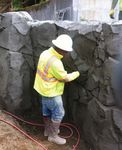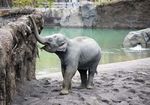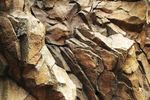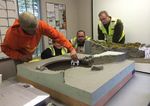Elephant Lands 2016 Outstanding Architecture | New Construction Project - American Shotcrete Association
←
→
Page content transcription
If your browser does not render page correctly, please read the page content below
2016 Outstanding Architecture | New Construction Project
Elephant Lands
By John Fulford
C
ontroversy surrounding keeping large mammals 1992, and so we were happily aware of some of the habits
in zoos has recently increased in the zoological and personalities of these behemoths. We knew that Packy,
community. The Oregon Zoo responded strongly the 54-year-old patriarch, enjoyed rubbing his belly on
and positively to this challenge by dedicating six acres rocks with striated rib-like textures at about 4 ft (1.2 m)
(24,000 m2) of their facility to the most ambitious and largest above grade. We also knew that the removal of the existing
exhibit built in their 128-year history: “Elephant Lands.” With work to make way for the new exhibit would entail patience
the health and welfare of the Portland community’s beloved and heavy equipment. We happily left that work to a demoli-
elephants as the guiding principle, a world-class exhibit tion contractor who exclaimed, “We had no idea concrete
was constructed over the course of 3 years, all while the could get that hard,” as they spent weeks breaking apart the
popular herd was kept on view to the public through a old shotcrete rockwork and pool. Shotcrete structures held
complicated series of construction phases. The result is a up to their notoriety as the strongest concrete in the zoo!
robust habitat that keeps the six elephants of the Oregon This was the fourth elephant exhibit Turnstone had
Zoo’s herd mentally and physically active with abundant constructed, which allowed us to participate in preconstruc-
behavioral enrichment opportunities (such as mud wallows tion meetings with the zoo’s animal management staff and
and a 160,000 gal. [605,000 L 3] pool for swimming and the architectural and engineering team. We knew that the
cavorting) while providing the public with an exciting and concrete surface textures needed to have high compressive
enriching experience that honors these magnificent animals. strengths to withstand the rubbing of an elephant’s leathery
This $57 million project was designed by CLR, a Phil- skin and at the same time be easy for them to walk on, and
adelphia-based architectural firm that is widely known that walls had to be engineered to withstand the same
and highly regarded in the zoo construction industry. The impacts as a highway guardrail (a long-used standard).
innovative engineering of the project’s shotcrete elements Our staff also brought construction options to the design
was performed by Armour Unsderfer Engineering, and the process that used shotcrete’s sustainability advantages.
General Contractor/Construction Manager for the project As an example, we promoted top-down soil nail construc-
was Lease Crutcher Lewis, one of the Pacific Northwest’s tion techniques to help save many of the trees in the areas
premier builders. that abutted the exhibit’s containment walls. This was an
The Turnstone Construction, Inc., crew had the pleasure important success because modern zoo design is based
of building the previous home for these elephants back in on the concept of habitat immersion—creating a sense of
timelessness to help zoo visitors realize the importance
of preserving the world’s natural habitats. Being able to
save large, mature trees in the background of these large
mammals is particularly important to this illusion. It is also
important to note that the substantially reduced excavation
required by the shotcrete-based method provided multiple
benefits, from less disruption to the animals and the public,
environmental advantages (saved emissions and lowered
fuel use), substantial cost savings, and schedule enhance-
ment. Thousands of yd3 (m3) of soil remained in place due to
this approach.
The construction process began with carefully shaped
clay models of the exhibit and three-dimensional samples
of each texture we would be sculpting. This was an impor-
tant means of communicating to the owner and design team
how we were interpreting a very subjectively judged scope
of work. We requested an interactive workshop to develop
the clay forms and review the samples so that we would not
Fig. 1: Clay models were developed to show mass and scale of have to reconfigure our shotcrete during the construction
the shotcrete elements of the exhibit process—clay being a much easier material to re-sculpt
18 Shotcrete | Winter 2017 www.shotcrete.orgFig. 3: Three-dimensional samples displaying the different
textures were prepared for approval prior to production
Fig. 2: Earthen textures with embedded cobbles, roots, integral
pigments, and topical stains
than hard shotcrete. This stage of the project built strong
team dynamics and trust that positioned us to work through
the challenges of a complex construction project.
The construction schedule was particularly interesting
because the elephants were to remain on view throughout,
which required safe and secure areas while the other sec-
tions of the new yard were being built. Every day counted
as we choreographed a ballet of large animals moving
between enclosures. Shotcrete as a method of construction
contributed to schedule enhancement in multiple ways. As
an example, the conventional concrete construction of the
deepest life support vault of the project’s pool would have
required closing the main access road to the site. However,
using temporary shotcrete walls constructed with top-down
soil nail techniques kept this from occurring, saving weeks
on the overall schedule. Animal management staff worked
closely with the construction team to develop the phasing
strategy and reported that the changes in location kept the Fig. 4: Shotcrete finishing for bedrock textures
elephants mentally and physically active while they were
moved between spaces. of eroding embankments in Asia. To make them as authentic
Construction also kept us mentally and physically active in appearance as possible we searched for images from
while we deployed plans and methods that used the full Asia so we could replicate specific features of the land. We
range of shotcrete’s versatility. On this site, we built tall, manipulated our textures to display the stratigraphy of the
architecturally finished walls that provided containment soil lens, replicating various soil types, including clays and
for the elephants (this required that the walls were at least sandy loam. We stained the surface of integrally colored
9 ft [3 m] tall with an overhang). These were textured with shotcrete to replicate the rich colors of Asian soils. In some
embedded roots and real cobbles to simulate the aesthetic areas, we purposefully showed the dynamic process of
www.shotcrete.org Winter 2017 | Shotcrete 19slumping soil by building erosional remnants of the same permanent wall face over a mechanically stabilized earthen
soil in the area below the eroded section of wall—a subtle structure and over a soldier pile wall. Existing form-and-pour
effect but one that strengthened the intended illusion walls were overlaid with shotcrete that was then textured to
and allowed further opportunities for the elephants to rub appear as large sections of native bedrock. Cantilevered
against different shotcrete textures. retaining walls were formed on one side and built with shot-
The project included two water-containing structures— crete. Two bridge abutments were installed using shotcrete
one being a large pool able to accommodate up to 10 mature that allowed viewers to walk over the elephants’ space. In
elephants and deep enough to allow them to fully submerge. each case, the structural method was chosen for its cost
These watertight shotcrete structures were placed monolith- effectiveness and schedule benefits, and in each case the
ically. Both pools accommodated complex support systems shotcrete process was central to the method elected. Ulti-
crucial to the elephants’ health that required detailing our mately, these structures were camouflaged using naturally
finishes around 40 pipe penetrations. The construction of textured shotcrete, which allowed them to blend in as an
these pools also entailed slab textures carefully detailed element of the elephants’ natural habitat. Shotcrete’s supe-
to be friendly to elephant feet. These water features have rior adhesion qualities were important to many facets
proven to be efficacious at inspiring play among members of the work.
of the herd. The construction and finished result of Elephant
Other applications of the shotcrete method included the Lands is a testament to the versatility of shotcrete. Over
lagging for top-down shoring techniques that were used to 1250 yd 3 (956 m 3) of shotcrete was placed with ACI Cer-
tuck a large building up against a hillside to keep it out of tified Nozzlemen in the exhibit scope of work, and five
the sightlines of the public, again while saving the mature different mixture designs were created to meet the shot-
landscape above. Shotcrete was also used to provide a crete requirements of the project, including waterproofing,
Fig. 5: Finished bedrock textures included painted lichens native
to the Asian habitat Fig. 7: Mother Rose-Tu and baby Lily cavorting in their new pool
Fig. 6: Part of the Oregon Zoo elephant herd traveling through Fig. 8: The youngest member of the herd exploring her
their new exhibit new habitat
20 Shotcrete | Winter 2017 www.shotcrete.orgstructural strength, aesthetic finishing, and pumpability. This project won the 2016 Project of the Year Awards
Integral pigments were added to the textural mixture with both the Daily Journal of Commerce (Oregon)
designs to help develop the organic palette of colors for and the Oregon Concrete and Aggregates Producers
the habitat. All the shotcrete material was supplied by the Assoc iation. Special thanks to the Oregon Zoo, Lease
Cemex Corporation. Crutcher Lewis, AUE Engineering, CLR Architects, and
Building a home for such magnificent animals made the the Cemex Corporation.
challenges along the way much easier to keep in perspec-
tive. At completion, it was exhilarating to witness the Oregon
Zoo herd walking together over sustained distances in a John Fulford founded Turnstone Construc
large exhibit yard that appeared to be from the forests and tion, Inc., in 1997. Based in the Pacific
savannas of Asia. This is particularly unusual for elephants Northwest, Turnstone has been building
in captivity. This feeling was only eclipsed by the joy of unusual shotcrete structures ever since,
watching the youngest elephant, 4-year-old Lily, swim including zoo and aquarium exhibits,
with exuberance while being carefully watched over by complex water features, climbing walls,
the older members of the herd! naturalistic hot spas, salmon spawning
streams, Hobbit houses, and simulations
of famous caves. Fulford has been involved in five zoo-
THE OUTSTANDING ARCHITECTURE | logical projects that have won the prestigious “Best Exhibit”
award from the American Zoo and Aquarium Association.
NEW CONSTRUCTION PROJECT
Project Name
Elephant Lands, Oregon Zoo
Project Location
Portland, OR
Shotcrete Contractor
Turnstone Construction, Inc.*
General Contractor
Lease Crutcher Lewis
Architect/Engineer
CLR Design, Armour Unsderfer Engineering
Material Supplier/Manufacturer
CEMEX CEMENTO
Project Owner
Oregon Zoo
* Corporate Member of the American Shotcrete Association Fig. 9: The highlighted area shows the scale of the six-acre
elephant exhibit in relation to the rest of the zoo
www.shotcrete.org Winter 2017 | Shotcrete 21You can also read


























































